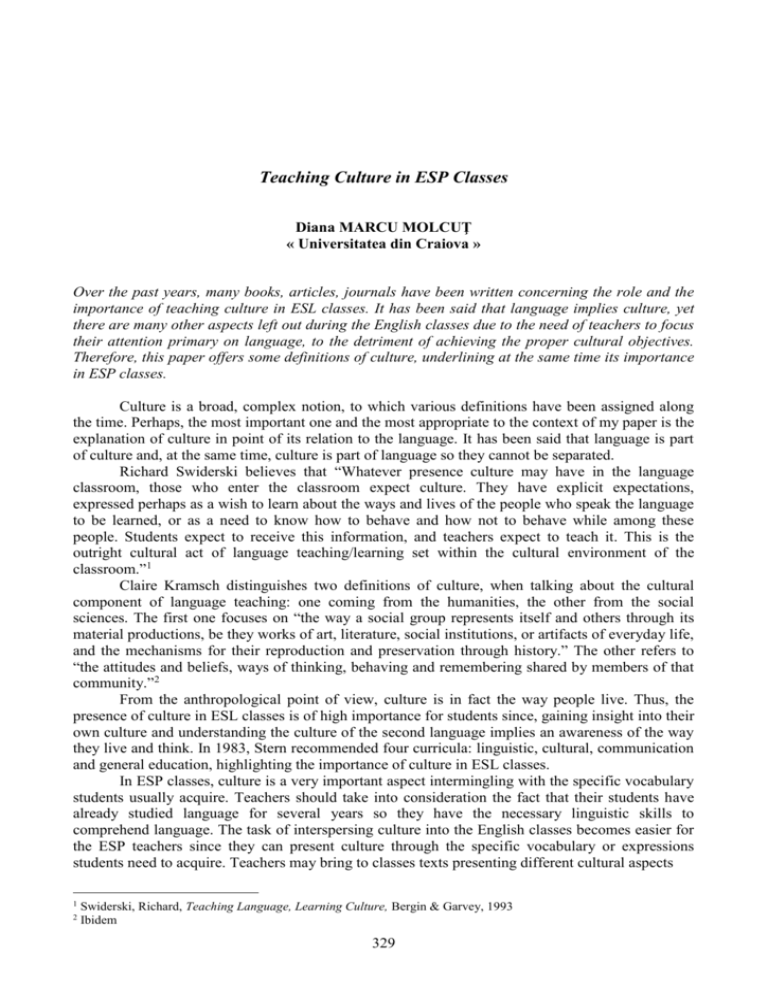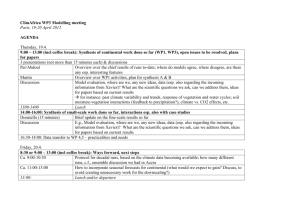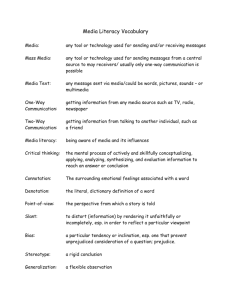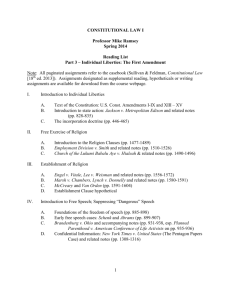Teaching Culture in ESP Classes
advertisement

Teaching Culture in ESP Classes Diana MARCU MOLCUŢ « Universitatea din Craiova » Over the past years, many books, articles, journals have been written concerning the role and the importance of teaching culture in ESL classes. It has been said that language implies culture, yet there are many other aspects left out during the English classes due to the need of teachers to focus their attention primary on language, to the detriment of achieving the proper cultural objectives. Therefore, this paper offers some definitions of culture, underlining at the same time its importance in ESP classes. Culture is a broad, complex notion, to which various definitions have been assigned along the time. Perhaps, the most important one and the most appropriate to the context of my paper is the explanation of culture in point of its relation to the language. It has been said that language is part of culture and, at the same time, culture is part of language so they cannot be separated. Richard Swiderski believes that “Whatever presence culture may have in the language classroom, those who enter the classroom expect culture. They have explicit expectations, expressed perhaps as a wish to learn about the ways and lives of the people who speak the language to be learned, or as a need to know how to behave and how not to behave while among these people. Students expect to receive this information, and teachers expect to teach it. This is the outright cultural act of language teaching/learning set within the cultural environment of the classroom.”1 Claire Kramsch distinguishes two definitions of culture, when talking about the cultural component of language teaching: one coming from the humanities, the other from the social sciences. The first one focuses on “the way a social group represents itself and others through its material productions, be they works of art, literature, social institutions, or artifacts of everyday life, and the mechanisms for their reproduction and preservation through history.” The other refers to “the attitudes and beliefs, ways of thinking, behaving and remembering shared by members of that community.”2 From the anthropological point of view, culture is in fact the way people live. Thus, the presence of culture in ESL classes is of high importance for students since, gaining insight into their own culture and understanding the culture of the second language implies an awareness of the way they live and think. In 1983, Stern recommended four curricula: linguistic, cultural, communication and general education, highlighting the importance of culture in ESL classes. In ESP classes, culture is a very important aspect intermingling with the specific vocabulary students usually acquire. Teachers should take into consideration the fact that their students have already studied language for several years so they have the necessary linguistic skills to comprehend language. The task of interspersing culture into the English classes becomes easier for the ESP teachers since they can present culture through the specific vocabulary or expressions students need to acquire. Teachers may bring to classes texts presenting different cultural aspects 1 2 Swiderski, Richard, Teaching Language, Learning Culture, Bergin & Garvey, 1993 Ibidem 329 closely related to the students’ future specialization; he or she may use visual materials bringing out important cultural facts, newspapers or magazines from that country with both cultural and factual content. Debates, role-plays and case studies shouldn’t be left out since they represent a great opportunity for students to express their opinions as well as to imagine how it feels to be “in the skin of a foreigner”. In 1987 Damen believed that the presentation of a critical incident in which some problems occur among people from different cultures is another important approach when teaching culture. Students take into consideration that specific situation and people’s reactions and comment on the cultural values represented by the actions of each. “Their objective is to reach a consensus on a course of action that would have been more appropriate in that particular situation”.3 Culture is present in all ESP classes no matter the students’ specializations: be they students in economics, sociology, theology, geography, so on and so forth, culture being closely linked to language and its use in order to communicate successfully and proficiently. For example, students in economics need to acquire the necessary knowledge concerning the culture of the second language, since, in their future careers, they might encounter different situations when they will have to be aware of the similarities and differences between their culture and the culture of the second language. The teacher may use texts concerning the monetary system of that particular country, its banking system, means of transport, ways of trading, etc. By means of these texts, students not only that they learn the specific vocabulary they are interested in, but, they find out new and interesting things about the country whose language they speak. Debates are also very important since the students have the chance to express their opinion on different subjects, also becoming aware of the main differences between the two countries. By learning expressions related to a telephone conversation, an interview, a negotiation, students become aware of the way they are supposed to act when dealing with foreign business partners. Courtesy phrases and nonverbal communication are of high importance for those students who will meet speakers of the second language in specific social situations that carry important implications not only socially but also psychologically. Thus, teaching communication implies teaching culture. Before studying a language, the student has to get in touch with a set of values and rules pertaining to that language. To the person who grows under such conditions, the above mentioned elements may seem normal but for the one who learns the new language and culture may seem strange. In the case of ESP students, it is important to be familiarized with the British and American culture, not only with the practical use of the language. If we take into consideration business students, in the near future, they will come into contact with lots of foreigners. Therefore, it will be essential for them to know that, generally American businessmen don’t like to talk around the subject but rather to get straight to the point. On the other hand, the British businessmen are oriented toward “fair play” 4, “they are usually very formal and polite”.5 The way these businessmen are dressed, the way they talk, their gestures are part of their culture. If a current business student becomes aware of all these cultural features, he/she will know how to act appropriately in each and every future business context. Another example is that of the students in sociology where the teacher, besides emphasizing the specific social vocabulary and terminology, makes the students aware of the cultural differences that may appear while studying the English language. Thus, the aim of the course is to sensitize students to how culture and communication are integrally related, introducing topics like patterns of culture, culture shock, and communication problems which arise primarily because of cultural differences. The teacher may bring into discussion social problems like racism, divorce, education, 3 Grigoroiu , Gabriela, An English Language Teaching Reader, vol. I, Reprografia Universitatii din Craiova, 2000, p. 258 4 Hendor, Donald, Hendon, Rebecca Angeles, Herbig, Paul, Cross-Cultural Business Negotiations,: Praeger Publishers, Westport, 1996, p.44 5 Ibidem, p.29 330 underlying cultural meanings, the students may try to find solutions for how to understand other cultures and how living in a foreign country and being open to an another way of life and thinking is liable to affect one's personality. At the same time with the improvement of their language and vocabulary, the students in geography are always confronted with cultural information offered by this field. Therefore, during the English classes, students face knowledge related to the geography of the second language country, its forms of relief, cities and towns, population, ecology, reaching proficiency in both their own language and the second or foreign language. If we take into consideration the above aspects, we get to the conclusion that the process of teaching a foreign language (English in my case), should necessarily include the notion of culture, otherwise its lack can lead to various barriers between communicators. The relation between culture and language is very strong. We all have to face at some point of our lives the problems of understanding a foreigner speaking despite our solid knowledge of his/her language. What may be the cause of this misunderstanding? The answer may be provided by the aspect of a different culture. My students drew my attention on a particular case that they experienced as a result of obtaining a job in the USA for the summer time period. Although they had an intermediate level of the English language, they had some difficulties in understanding their working American colleagues. Certain expressions that the American students used during conversations, sounded rather unfamiliar and incomprehensible to the Romanian students. Sentences like: “We shall check out that movie next week after work” or “I would never ask Steven to help me; he always whines about everything!” would have been totally misunderstood if the American students hadn’t explained their meanings (check out = to watch; to whine = to complain). In “Teaching ESL Composition: Purpose, Process and Practice”, Dana R. Ferris writes about a similar experience due to her first contact with the Americans. She mentions that “the American slang and dialects can cause difficulty for international students to relate with American students. If an American student uses slang words like “word up” or “chill” in their conversations with a foreigner, they could end up with miscommunication or no communication at all […] That’s how I coped with English when I first arrived to the United States. I didn’t understand the American’s dialect and slang”.6 On a whole, coming into contact with a new culture is an exciting experience. However, it is also true that, not being prepared to interact with a new culture can lead some of us to a state of isolation and dissatisfaction toward the impossibility of understanding our foreign colleagues. Not all the people are ready to adapt to a new culture, but, if taught correspondingly, they may pass more easily through the experience of a new culture. Therefore, an English teacher, especially in the ESP classes, should pay much attention to the cultural aspect of the language. At present, when our country is almost part of the European Union, great interest should be given to all features of the English language. Culture is also interconnected to communication in the sense that it helps people encode messages; it helps them determine the meaning of these messages and the conditions when these messages can be sent, received or used. Nowadays, communication in English is more than ever emphasized by the language teachers. Socializing accurately and effectively in a foreign language is considered a great advantage in obtaining a job. Also, writing a correct application letter, a CV, a memo in English or passing an interview at an international company are the main goals of the present student. But what is the link between culture and communication? As Gunther Kress states: “the structures, processes 6 Ferris, Dana, Hedgcock, John, Teaching ESL Composition: Purpose, Process, and Practice, Lawrence Erlbaum Associates, 1998, p.58 331 and contents of communication are given by culture[…] Culture sets the ground entirely for communication and for how is communicated. […] communication is a cultural process”.7 The main argument for teaching culture in ESP as well as in ESL classes is not only a linguistic one: “in order to understand language fully and use it fluently, learners need not only linguistic, pragmatic discourse and strategic competence but also socio-cultural and world knowledge”8. The recent language and culture teaching methodologies suggest a move away from the cognitive approach and an attempt to offer many historical, geographical and institutional data at the same time with the teaching of the language skills, mainly using the communicative approach. As a conclusion, culture is very important in ESP classes, offering students the chance to behave correctly whenever they meet a member of another culture and to mediate attitudes and viewpoints of their own culture and those of the target culture. Bibliography: Ferris, Dana, Hedgcock, John, Teaching ESL Composition: Purpose, Process, and Practice, Lawrence Erlbaum Associates, 1998 Grigoroiu , Gabriela, An English Language Teaching Reader, vol. I, Reprografia Universitatii din Craiova, 2000 Hendor, Donald, Hendon, Rebecca Angeles, Herbig, Paul, Cross-Cultural Business Negotiations, Praeger Publishers, Westport, 1996 Kress, Gunther, Communication and Culture: An Introduction. Contributors, New South Wales University Press, Kensington, 1988 Pachler, Harbert, Teaching Modern Foreign Languages at Advanced Level, Routledge, 1999 Swiderski, Richard, Teaching Language, Learning Culture, Bergin & Garvey, 1993 7 Kress, Gunther, Communication and Culture: An Introduction. Contributors, New South Wales University Press, Kensington, 1988. p.10 8 Pachler, Harbert, Teaching Modern Foreign Languages at Advanced Level, Routledge, 1999, p. 90 332 333







